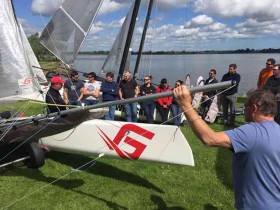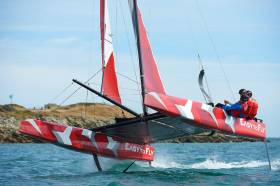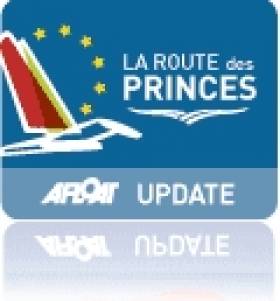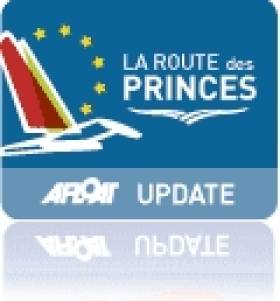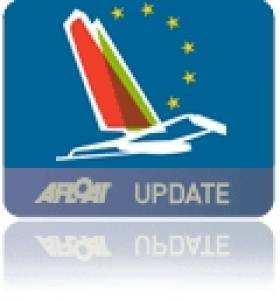Displaying items by tag: Multihull
Multihulls on East Coastal Raid 2019 from Howth to Wicklow
A few years ago, well actually it’s pushing on eight years now, four Hurricane 5.9 catamaran’s from Swords Sailing and Boat Club (SSBC) sailed from Howth Yacht Club to the Rockabill Lighthouse and back writes multihull sailor Stephen Broaders. I was onboard one of them and we spent a long time talking about how great it was to do a long passage type sail on fast beach cats and that we should definitely get out on the Irish Sea again soon
There were many coastal races or rallies on catamarans in years gone by such as the Lambay race, Skerries to Clogher Head, an Irish Sea crossing and other parts of the Irish coast around Cork, Galway and more.
So year after year passed by and we would occasionally mention the idea of doing another long coastal trip. Most of the Hurricanes had switched to the more modern F18 class as a result of the World Championships coming to Ballyholme in 2014. In the following years more joined us and we found ourselves going to the F18 World Championships in Germany 2015, Denmark 2017 and Spain 2019 for big fleet world-class racing which was and is a fantastic experience but in the backs of our minds we all still had this desire to get some coastal sailing done in Ireland
So late last year with a bit of pestering from a certain tall South African in our fleet and a chat with his crew who happens to be a member of Wicklow Sailing Club I decided to hell with it I’m gonna get this thing organised. I called the IMA Chair and asked could I put a date in for a coastal raid from north Dublin to Wicklow, he said yes, absolutely great, yes do it!
So I got the date set and put it out there to the fleet, we got commitments from four boats to do it. With about two weeks to go, I called Howth Yacht Club and asked could we launch from there and they very kindly said yes, providing us with excellent facilities as they had with the Rockabill trip eight years earlier. At the same time the crew I mentioned earlier contacted Wicklow SC who were delighted to assist so all was in place for our grand return to the open seas.
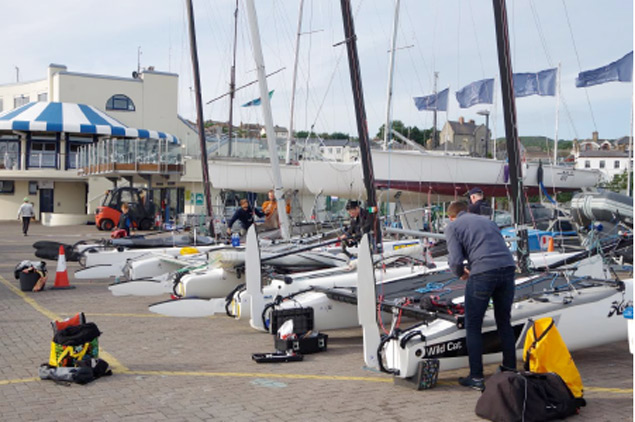 F18’s in Howth Yacht Club - a C2, Nacra Infusion, Hobie Wildcat & Hobie Tiger
F18’s in Howth Yacht Club - a C2, Nacra Infusion, Hobie Wildcat & Hobie Tiger
In the week leading up to our Saturday departure we all started watching the weather forecast but as each day passed the wind predicted got lighter and lighter. By Thursday it was actually showing 0 knots gusting 2 in Dublin Bay and I thought oh well that’s that scrapped. Friday came and it showed a marginal improvement we had some breeze 6 knots or so but still not quite enough.
By 12 noon I was thinking of canning it as the phone rang, it was from a Mini Transat sailor from Galway who persuaded me to go ahead and set sail early, he had spent a bit of time looking at weather patterns and forecasts and was sure it would be ok. I also had the South African desperately trying to get back for it with delayed planes & taxis etc who was looking forward to it and didn’t want to disappoint him, So I said ok let’s go ahead,
A very long day ensued with boat derigging, re-rigging and bringing cars, vans and trailers to Wicklow and eventually getting back to Dublin for 1:30 am for a few hours sleep.
We all got ourselves over to Howth for 7:30 am and I looked at the forecast in the taxi en route and hallelujah it was showing 10 knots gusting 16.
"At 9:30 am we set sail from the mouth of Howth Harbour, escorted out by a very curious seal"
After an hour and a bit getting one boat finished and all the sails hoisted we were ready to set off. Many thanks to Howth YC for accommodating our early start.
At 9:30 am we set sail from the mouth of Howth Harbour, escorted out by a very curious seal all the boats stayed together as we rounded Howth Head, accompanied by a cover RIB from SSBC.
After a bit of tricky sailing passing the Cliffs of Howth, we headed out across Dublin Bay. With no ships passing, we began to sail fast with spinnakers flying part way and two sail reaching the rest. As we got halfway the excitement was building on each boat as we realized we are doing it and the conditions are perfect. We sailed on passing Dun Laoghaire reaching Dalkey island within 30 minutes of leaving Howth harbour. Smiles all round especially on the Hobie Tiger where Sean Lemonnier, age 11, a very promising and enthusiastic young cat sailor was having a blast out on the wire downwind.
After a quick chat to the local fishermen on the water in Dalkey, we headed for Bray, stopping there just off the beach for refreshments. They probably don’t know but the Bray airshow had f18s flying by...well kind of!
On again and out around Bray Head towards our next regrouping spot Greystones. We were hitting top speeds of 20knots at this point in flat water and 20 degrees, Perfect.
 A Multihull heading for Wicklow Sailing Club
A Multihull heading for Wicklow Sailing Club
Waiting for us on the water in Greystones was a RIB from Wicklow Sailing Club which had made its way up to assist with cover. After we made contact with them on VHF radio and another regrouping we continued on flying spinnakers and gybing every 10 minutes or so in an exhilarating
impromptu race to Wicklow, with one boat going inshore, two going out and in again crisscrossing in close quarters, everyone had a smile from ear to ear, it truly was magical and if you ask each of us to describe the experience we just don't have the words to articulate it.
Finally we made it to Wicklow Harbour to a great welcome from Wicklow SC, we were cheered into the slip and helped up to the club where we were fed & watered by a very enthusiastic & generous group of fellow sailors at the club before heading back out to take part in their round the cans racing with the juniors

A truly great weekend of sailing with lifetime memories, well done to all those who took part and helped to make this happen, long-distance raids are definitely back on the calendar going forward, now to start planning the next one, whos up for it?
Sailors
The author - Stephen Broaders – Nacra Infusion- Sword Sailing and Boating Club (SSBC) The tall South African- Wyatt Orsmond – C2 -SSBC
His crew from Wicklow - Patrick Billington – C2 - WSC
Mini Transat sailor - Yannick lemonier – Hobie Tiger - GBSC
The other sailors
Pawel Trojanowski Hobie Wildcat - SSBC Sean Duranbusch Hobie Wildcat -SSBC Siobhan Broaders Nacra Infusion -SSBC Sean Lemonnier Hobie Tiger - GBSC Laurick Mathieu Hobie Tiger - GBSC
Special thanks to –
Dermot McHugh RIB - SSBC Kinga Trojanowska RIB -SSBC
Evan Orsmond and Conor Kavanagh helping with rigging and de-rigging. Fred Connolly, Marina Supervisor Howth Yacht Club
Caroline Gore-Grimes Honorary sailing secretary Howth Yacht Club
Wicklow Sailing Club (WSC)
David Balesty – Race Official - WSC Kyran OGrady – Rib (Commodore) - WSC Isobel OGrady – Rib - WSC
Denise Cummins – Onshore support, BBQ – WSC
Mark Redmond – Onshore support, Bar - WSC Richard Swanston BYC - IMA CHAIR
Swords Sailing Club (SSC) hosted Australian multihull sailor Mitch Booth who competed at no less then four Olympics in the Tornado class, medaling twice. Here Patrick Wodhams of SSC describes the training weekend with the sailor who has competed in 64 World championships and won 10 of them.
Mitch now resides in sunny Spain and is in demand around the globe advising and training with Olympic teams and class associations. Some of us were lucky enough to meet and race against him at the 2017 F18 World’s in Denmark.
With eight F18’s, two Hurricane 5.9’s and one F16 in attendance, Mitch brought the sun with him from Spain, day one looked like we would have no wind as a result; the forecast was quite light. However, first up was a briefing in the club house; going over all that secret racing stuff we all want to know. Tuning, boat handling, tactics/strategy, starts, acceleration, mark rounding’s, tacking/gybing and of course going fast……
Armed with some of that secret knowledge, like gladiators ready to tend their chariots we rigged our boats, 1 extra notch here, an extra pound on the Loos gauge there; with brief boat on boat one on ones with Mitch. By the time we had finished and got kitted up, we were greeted by the start of a fantastic sea breeze building as we launched our boats for our first on the water session.
If you have been lucky enough to compete at a World’s or any big fleet racing, you will know that starts are crucial. Boat handling is key to parking the boat and making sure you don’t collide with anyone; most importantly that you get away fast into clean breeze from the front row and don’t get rolled or spat out the back. Assistant coach Dermot McHugh and his brother Kevin ferried Mitch around and laid the marks for our quick turn around practise starts, each with varying degrees of success and one or two boats OCS or so we thought.
After lunch the fairly constant sea breeze created almost perfect champagne sailing conditions. We progressed to a one lap race after every third start finishing downwind with crews trapezing and kites flying.
After a fantastic first day, we headed back into a debrief session utilising excellent drone footage courtesy of Kinga Trojanowska. There was no hiding and the guilty OCS culprits were well and truly outed, all in good jest. A delicious barbecue and refreshments followed with some great stories to be heard form Mitch and all.
Day two started exactly the same as day one with the sun shining and not much breeze. Following a quick briefing in the clubhouse, we congregated around one boat in the boat park as Mitch went through rigging and tuning for all the varying conditions. Sail shape and airflow over it, are all influenced by the many controls at the helm and crews disposal, getting them all in the optimum position at the right time is somewhat of a black art; times that by three to include the mainsail, jib and gennaker and you can see why this crucial knowledge separates the master from the pupil. Following Q’s & A’s everybody agreed and enlightened by a true master.
As we consumed a quick lunch the magnificent sea breeze had kicked in, we launched and sailed a square course to cover all points of sail as Mitch and Dermot followed us round with varying tips on what we could do to improve. By 2pm we joined the Swords scheduled racing for the afternoon and put into practise all that we had learnt. We were joined on the water by quite a few Lasers, and other boats that made up the remainder of the Swords fleet. Great fun as we weaved in and out on a fantastic sailing weekend finally.
New Foiling Catamaran Is ‘Easy To Fly’
#Foiling - Orders are flying in for a new design foiling catamaran, according to its French makers.
Easy to Fly is the brainchild of solo sailor Jean-Pierre Dick, who placed fourth in the most recent Vendée Globe, and Guillaume Verdier, designer behind the new foiling One Design monohull chosen for future editions of the Volvo Ocean Race.
The 26ft multihull is designed to fly safely from a wind speed of 8 knots with three people on board — and is likely to be a future fixture on a French sailing scene that’s fully embraced foilingfoiling as a discipline.
Launched in September 2016, sales for Easy to Fly are up to six across Europe — including one to England, to the team behind the Open7.50 Cool Runnings, who will take delivery of their boat next week.
Foiling is in right now. And with Olympic hero Annalise Murphy leading the Irish charge in the relatively new class, there’s never been a better time to get on board and get flying on foils.
Visit www.EasyToFly.fr for more.
Pre–Owned Multihull Boat Show Next Month in France
The second edition of the Pre-owned Multihull boat show takes place in Canet-en-Roussillon in the South of France near the Spanish border.
The show is an indication of the growing demand for multihulls coming from owners seeking longer live–aboard opportunities.
The Nautipole and boat show organiser M2O will exhibit about 30 pre-owned power and sailing catamarans from 37 to 82 feet on the pontoons of the Yacht harbour. An exhibitor village will offer multihulls services and equipment.
The event runs from Thursday October 6th to Sunday 9th in the Yacht harbor of Canet-en-Roussillon.
The shows opening hours to the public are from 10 am to 6 pm. Entry is free.
Irish Open Multihull Championships 2015 Defended by Flack & Swanston
Last weekend, September 12th-13th the Carlingford Sailing Club hosted the Irish Open Multihull Championships 2015. Sailors arrived on Friday night to 40 knot winds and driving rain not deterred at all they set up tents! After a few hours the tents had been trashed, so several competitors had to take to the race office shed…. a very cosy welcome to Ireland. Simon Flack was over to defend his title won last year at Lough Neagh, sailing this year with multi-Irish champion crew Barry Swanston. A wrap up by Richard Swanston.
Download results below as a jpeg file.
The open fleet format with all types of catamarans from a catapult to an F18 rated under SCHRS and racing an equal number of windward – leeward and triangular courses (to balance performance strengths) was used with all boats starting off the same start line. Classes were also subdivided into C1 and C2 fleets for individual fleet prizes. Saturdays forecast was gloomy to say the least. Rain and 25 knot baseline gusting to 40 knots from the S.W. To this, add the infamous Carlingford Kettles roaring off the top of the hills at all angles ripping up mini tornadoes of water that march and meander across the Lough ….not to be missed!! After much head scratching and nervous looks to the broken water in the lough and vicious squalls rolling down off the hills, it was decided (after a postponement) to ‘ give it a rattle sure’! We were treated to an unexpected two races in variable but safe conditions.
Saturday – Race 1 & 2
pre startSwannie and Jenni executed a perfect port tack start only to fall into the pack mid first beat. The fleet then had several place changes throughout the race with Simon Flack & Barry Swanston quickly getting used to the Cirrus and had a great race with Wyatt Orsmond & Patrick Billlington in their new Goodall C2. With an increase to the breeze, the Hurricane 5.9 sx with it’s Irish Aussie pair were flying. Wyatt pipped them at the post to secure his first bullet. Swannie and Jenni Brittain were 3rd. Again in Race 2, the pattern was set with the Orsmond/Billlington and Flack/Swanston leading the way with very competitive sailing throughout the race. Simon Flack settled to the Cirrus and pulled off a great first place.
Sunday – Race 3, 4, 5 & 6
Sunday sore heads woke to a much more benign weather picture with Carlingford looking its glorious best: a gentle southerly 4knots to 8knots the forecast. We all sailed out in sparkling 10-12 knots kites up in bright sunshine!
With the wind freshening racing was tight in both the C1 and C2 fleets. Flack/Swanston again came out on top with Orsmond/Billlington in 2nd place and Shane & Matthew Hatton coming in 3rd again. Race 4 (triangle course again) the wind was now a steadyish 15- 18 knots, with the tidal influences beginning to take effect. The judging of lay line was proving critical both upwind and downwind. Swanston was boxed out whilst leading at the start finish gate and the leaders then misjudging the downwind gybing angles to allow the fleet to group together for a frantic last high speed lap! David Biddulf sailing with newbie to cats Stephen Magee had an incredibly close race with Si and Baz to win by 1 second with Wyatt in the C2 snapping at their heels 19 secs behind. Race 5 (windward–leeward) the Flack/Swanston and Orsmond/Billlington flew away in this race with only seconds separating them, throughout Flack/Swanston winning by only 11 seconds! The Aussi Hurricane 5.9SX showing some blistering pace up wind and down unfortunately having some gear failure lead to a clearing of the heads! The Shockwave in third place again. Race 6 belonged to Wyatt and Paddy in their C2 leading from start to finish. Swannie and Jenni showed some great pace in the breeze to have a dingdong battle with Si and Baz the battling Jenni (girlfriend) beating the master of the hoist baz (boyfriend) to the fill the kite and powered over the Cirrus at the spreader mark. The battle continued to the last beat when just as the Shocker rolled the Cirrus Swannie’s mainsheet broke!
The white sail boats had close racing between Dermott Mangan (dad) in his amazing Catapult and Neil Mangan (son) with Simon Griffin as crew on their Dart16. Both gaining excellent overall placing under S.C.H.R.S. They may have done even better with a longer second leg to the gybe mark improving the angle between the marks. So overall went to Simon Flack and Barry Swanston by one point. Great racing! C2 fleet was won by Neil Mangan from the evergreen Dermot Mangan. Travellers Trophy was won by Wyatt.
#multihull – Competitors from all the cat clubs came to Ballyholme Yacht Club last weekend to have some great racing over short course format with multiple starts. Saturday dawned with little and fickle winds but when the SW building breeze settled the fleet was treated to five competitive races. Adrian Allen and Barry Swanston were in dominant form with five wins.
A great challenging NW breeze of 15kts – 22 kts met us on Sunday to test every one with very fast downhill rides. Adrian and Barry again won the races, but with all five leading F18's hitting the top mark together in a wall of spray and curses racing was very competitive !
Wyatt Orsmond in his new Goodall C2 from Blessington Sailing Club was however biting at his heels finishing second overall and is sure to provide stiff competition in the events to come.
Maxie who was put in at the deep end with Biddy from Swords Sailing Club may well have wished for a softer introduction to Catamaran F18 sailing but finished extremely well in third place. Jenni Brittain sailing with Swannie in her first Irish event counting only a few hours F18 sailing experience had some very encouraging results and began to show some form even in the big breeze, finishing on joint points with Biddy and a very bruised Maxie, loosing out on discard to fourth place.
Lagoon 52 Multihull Now Cruising Irish Shores
#multihullsnews – In a novel move from MGM Boats, the Irish boat sales firm have brought in a Lagoon 52 Cruising Catamarans from France for a ten week demonstration period around the Irish coast. From the above picture it's clear she's already done the rounds off Cork and is now heading to Dublin Bay for several weeks of demo–sail appointments at Dun Laoghaire.
The Lagoon 52 is a high volume cruising catamaran incorporating a large flybridge steering station, a radical aft-stepped mast and self-tacking genoa that makes this big yacht so easily managed by the smallest of crews. More on the boat on Afloat boats for sale here.
#Spindrift - The race-winning multihull Spindrift has capsized in gale force winds off Dun Laoghaire this afternoon (22 June) at the start of the Route des Princes series of inshore racing spectacle on Dublin Bay, as David O'Brien reports on scene.
The MOD70 trimaran that was first into Dun Laoghaire from Lisbon on Wednesday capsized meres from spectators in Scotsman's Bay ahead of the first of three inshore races.
Rescue photos below.
The accident happened about 700 metres off the starting line in the first race, as the boats were accelerating in the strong and gusty winds. The boats were not carrying full sail as a precaution against the strong offshore winds blowing in the bay. Today's in–port racing was billed as 'fast and furious'.
At least one person is injured and is being treated upturned hull of the stricken craft. As of 3.08pm a rescue helicopter was dropping its winchman to the vessel.
It is feared by National Yacht Club personnel that the mast of the inverted trimaran is stuck in the sea bed and may be broken.
All racing has now been postponed as rescue services attended the scene. Eight crew were onboard the vessel at the time of the capsize.
Update 3.10pm: All other boats have returned to Dun Laoghaire Harbour as rescue services continue to attend to the capsized Spindrift and its crew.
Update 3.18pm: Weather conditions in Dun Laoghaire continue to be strong and gusty, and it's reported that some local DBSC RC racing had already been cancelled earlier today.
Update 3.27pm: A news update on the Route des Princes website (via @sailracewin) says one crewman on the upturned Spindrift has a back pain.
Update 3.35pm: Twitter users Mark Lloyd (@Lloyd_Images) and Philip Bromwell (@philipbromwell) have posted photos of the failed Spindrift in Dublin Bay as emergency services attend to the scene.
Update 3.39pm: The crewman casualty has been winched to the helicopter and is being airlifted to Tallaght Hospital. His condition remains unclear.
Update 3.41pm: Triage for any injured racers has been set up at the National Yacht Club and all rescue boats have been asked to report to the NYC to account for numbers.
Update 3.53pm: Assessments are currently being made as to how to recover the 70ft hull still floating north of Dalkey Island.
Update 4.04pm: Sailing journalist Kate Laven comments on Twitter re the Spindrift capsize: "Everyone recovered but two injured"
Update 4.08pm: The Route des Princes website has followed up its earlier update with a news post which confirms that weather conditions at the time of the Spindrift capsize were 20 knots with strong gusts.
Update 4.55pm: Dun Laoghaire lifeboat towing the upturned Spindrift hull (minus mast) towards Dun Laoghaire harbour
Update 6,00pm: The upturned hull has been successfully righted, the hull is intact but the mast is broken.
Update 7.00pm: There are unconfirmed reports that the injury to the Spindrift crew man is a broken pelvis.
Update 8.00pm: Spindrift racing team release statement on capsize and injury to crew member
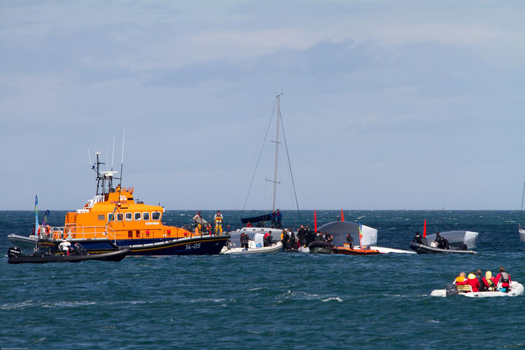
Rescue craft, local boats and the Dun Laoghaire lifeboat attend the upturned hull. Photo: Gareth Craig

The Coastguard helicopter arrives on scene and a winch man is lowered to make an assessment. Photo: Afloat.ie

Rescue personnel and Sprindrift crew on the upturned hull in Dublin Bay this afternoon. Photo: Afloat.ie
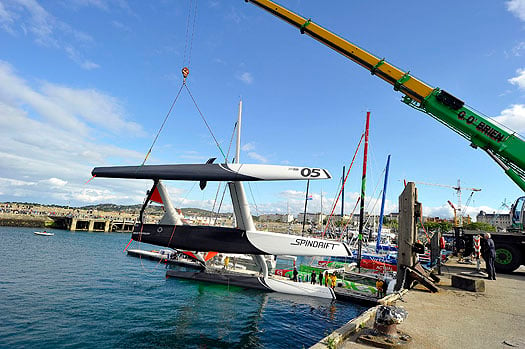
Spindrift minus her mast is lifted in Dun Laoghaire harbour this evening. Photo: Michael Chester
#rdp13 – Passing up this morning's promising weather window for a Round Ireland speed record attempt, the Routes des Princes grand prix multihull fleet will compete as scheduled in Dun Laoghaire this afternoon in what will be a series of heavy weather inshore races.
South–westerly winds are gusting to 25 knots on Dublin Bay one hour before start-time.
Nine multihulls will be racing with six key races planned over Saturday and Sunday for the four strong MOD70 fleet. Valuable race points tallying towards the overall scores for this new multihull race around Europe from Valencia, Spain to Morlaix, France are up for grabs for the MOD70 class.
Three races will be contested from 2pm this afternoon with a further three tomorrow (Sunday) when the winds are due to be even stronger. Courses are set as close to the land as possible to allow spectators a grandstand view of the action.
Visitors to the free La Route des Princes Festival on the East Pier will have the perfect vantage point with live commentary from Irish Olympic sailor Ger Owens and Fiona Bolger.
The substantial shoreside festival opened this morning, and there is a range of different exhibitions and stalls.
The food festival "With Taste" is organised for the general public with small tasting tents offered by restaurateurs and food producers.
Racing should finish around 1600hrs. During the afternoon and evening there is live music in the bandstand until 2130hrs.
At 1830hrs the public prize giving for Leg 2, the stage from Lisbon which finished on Wednesday morning, will be held on the pier and thereafter at 1900hrs Saturday, an autograph session skippers to the public followed by live music.
There are family entertainments for all ages right through the weekend with more live racing and music on Sunday. The Routes des Princes will leave Dun Laoghaire on Monday 24 for an 11am start at the Kish Lighthouse. Depending on weather conditions the fleet will attempt to break the round Ireland speed record.
Cork Announced as Stopover Port in 2013 French Multihull Race
#multihull – No sooner have the MOD 70s left Dublin Bay than Cork is the next venue for giant multihull visitors for the first edition of the Route des Princes that will take place from 9th to 29th June 2013.
The event will be based on multihulls measuring in excess of 40ft. The boats will arrive in Cork from Wednesday 19 June and depart on22 June. The route will take the form of a genuine tour of Europe's regions according to a French press statement released today as follows:
Spanning Valencia (Spain) and the bay of Morlaix (Brittany), via Lisbon (Portugal), Cork (Ireland) and Plymouth (England), the route will provide a dense and comprehensive racecourse, punctuated by events at each of the stopovers. The top sailors, the fastest boats of the age, an event already deeply rooted in regions of great richness: a new European race has been born!
In homage to performance...
For what seems like forever, the exchanges between sea and land have maintained the richness of the different territories, yet the events likely to show them to advantage are few and far between. Committed to promoting their skills and their culture through a strong and long-lasting presence in the world of offshore racing, the producers at "Prince de Bretagne" were keen to create a race that truly reflected their values. Aimed at all manner of multihulls, from 40-footers to the giant record hunters, MOD70s as well as Multi50s, today the Route des Princes is the only meeting geared exclusively around such craft. On two or three hulls, the top names will race alongside enthusiastic amateurs as they come together to write the opening lines of an epic that will set sail from Valencia on 9 June 2013. With around twenty boats expected on a shared start line, the stage for what promises to be an unprecedented standard of competition will be set the moment the starting gun sounds. Punctuated by a series of authentic stopovers, this event won't simply pitch up in towns across Europe with great fanfare. It will impact the locals and their lives, by revealing the true fabric of Europe woven by those at sea and those working the land. In the process, both the skippers and their partners will benefit from a warm welcome wherever they go, snapping up the opportunity to let others explore their boats and all the riches of European marine technology. From the Mediterranean to the North Sea, from Spain to Brittany via Portugal, Ireland and England, alternating between long courses and genuine sprints, the Route des Princes promises to be resolutely geared towards diversity.
... A festival for all European regions!
The maritime and competitive aspect of this event will be further boosted by a very strong emphasis on Europe's region. In this way, each host town and city will have the chance to show off its riches, be they agricultural, gastronomic, traditional or cultural. The Route des Princes' ports will enable the public to rediscover the magic of major oceanic meetings and get up close to the sailors and their boats. Each stopover will correspond with an already existing, well-established event for the people: the giant paëllas and grand chef competition in Valencia, the City Festival in Lisbon, the concerts in Cork, the Barbican festival in Plymouth and France's grand finale, the "Entre Terre et Mer" ('Twixt Land and Sea) festival, the second edition of which will transform the bay of Morlaix into a communion of sailors, fishermen and farmers. Steadfastly open, the race village will be at the very hub of the entertainments programme. A totally innovative festival, the Route des Princes will satisfy the needs and aspirations of Europe's regions, the public and sportsmen and women everywhere.
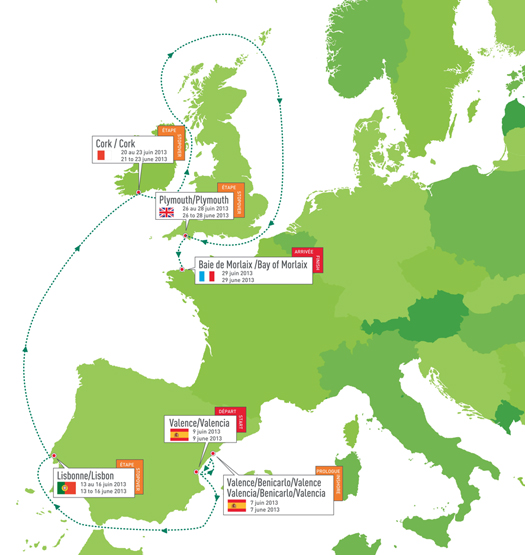
From 9 to 29 June 2013, all the sailors, all the lands and all the public will come together in the Route des Princes!
Quotes:
Jean-François Jacob, Secretary-General of the St Pol Sica, Manager of Prince de Bretagne: "We felt that it was in the interest of all the owners and skippers of multihulls to have an extra event to support their programmes. We were keen to have an event, which gathers us all together and highlights our very strong link with the sailors. Like them, we're subject to the vagaries of the weather on a daily basis and if we manage to grow vegetables year round in northern Brittany it's thanks to the influence of the sea and the Gulf Stream. Through the Route des Princes, we want to show that the land-based world is a source of dynamism in a number of regions across Europe. This notion is something Prince de Bretagne's producers hold dear and they want to share this with others. Our aim is to enhance the prestige of the different territories and to enable the greatest possible number of people to discover them thanks to an event for the people, which will be a celebration of all the different trades at sea and on land".
Lionel Lemonchois, skipper of the Maxi80 Prince de Bretagne: "The concept is an attractive one because it is reminiscent of the original European Tour, a race which existed in the 90s and always proved to be extremely popular. It's always nice to switch from one country to another, especially when racing in crews. The Route des Princes is really offering a fine course. It is also important to be able to associate oneself with something other than sailing as it gives things a new twist and thus has greater appeal for us and for the public."
The dates for the Route des Princes
Valencia
Start Sunday 9 June 2013
Lisbon
ETA Wednesday 12 June
Departure Saturday 15 June
Cork
ETA Wednesday 19 June
Departure Saturday 22 June
Plymouth
ETA Thursday 27 June
Departure Friday 28 June
Baie de Morlaix
ETA Saturday 29 June
Prince de Bretagne
Situated in northern Brittany, in traditional vegetable producing country, Prince de Bretagne, which exports to over 30 countries, is the standard bearer for a whole network of services related to producing fruit and vegetables: research, production, commercialisation-shipping, communication and a training college. Brand leader in the world of fresh fruit and vegetables, with a range of 87 species and 2,350 producers, Prince de Bretagne is at the service of the consumer in providing the best possible standard in terms of safety, health and taste.
The general organisation of the event will be taken care of by the Société Commerciale pour la Promotion des Territoires (a Marketing Company concerned with the Promotion of Europe's Regions), a subsidiary of the St Pol de Léon Sica in Brittany.





























